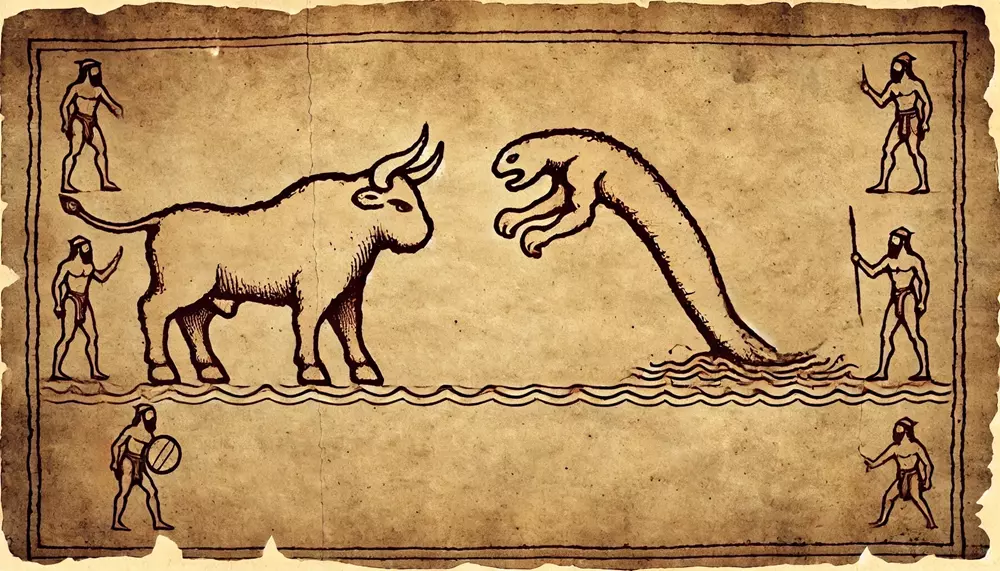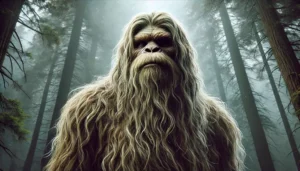Behemoth: The Colossal Land Beast of Jewish Mythology
The Behemoth is a legendary creature from Jewish mythology, often described as a massive beast that roams the land, embodying the untamed forces of the earth. Known for its immense size and strength, the Behemoth stands as a symbol of power and resilience, mirroring the ferocity of the Leviathan in the sea. Representing the land element, the Behemoth is believed to appear during the End of Days to battle the Leviathan, showcasing the eternal struggle between land and sea, stability and chaos.
Origins and Mythological Background
The Behemoth’s origins can be traced back to the Hebrew Bible, particularly in the Book of Job, where it is depicted as a creature of enormous strength and size, created by God as a testament to divine power. Unlike the Leviathan, which is often associated with chaos, the Behemoth is portrayed as a stabilizing force, tethered to the land and symbolizing the indomitable power of the earth.
The Behemoth in Jewish Texts
Jewish texts describe the Behemoth as a giant land creature with a body so large that it could only be restrained by divine power. Its strength is unrivaled, and its presence is often associated with the creation of the world. According to some traditions, the Behemoth and Leviathan were both created during the time of Genesis, each representing a different element and force of nature. While the Leviathan dominates the seas, the Behemoth rules the earth, and together, they symbolize the balance of nature.
The Behemoth’s role in Jewish eschatology is significant, as it is said to be one of the creatures that will appear at the End of Days. In these apocalyptic tales, the Behemoth will battle the Leviathan in a climactic showdown that will decide the fate of the world. Some stories suggest that after this final battle, the Behemoth will be served as a feast for the righteous, signifying the ultimate triumph of order over chaos.
The earliest reference to the Behemoth appears in the Book of Job from the Hebrew Bible. The specific source is Job 40:15-24, where the description of Behemoth is provided as follows:
“Behold, Behemoth, which I made as I made you; he eats grass like an ox. Behold, his strength in his loins, and his power in the muscles of his belly. He makes his tail stiff like a cedar; the sinews of his thighs are knit together. His bones are tubes of bronze, his limbs like bars of iron.” (Job 40:15-18, ESV)
This passage is well-known as the primary textual source in Abrahamic traditions, and it illustrates Behemoth as a powerful creature created by God, emphasizing its immense physical strength and presence in the natural world.
Cultural Impact and Evolution
The Behemoth has captured the imagination of various cultures over centuries, becoming a symbol of strength and resilience. Its portrayal as a guardian of the land reflects humanity’s respect for the natural world and its awe of the earth’s unyielding power.
The Behemoth holds a prominent place in Judeo-Christian traditions and has impacted various cultural practices over the centuries:
- Jewish Passover Haggadah
In some Jewish traditions, the Behemoth is mentioned during Passover as part of apocalyptic lore, symbolizing divine power and the promise of redemption. During the reading, it’s said,“In the days to come, the righteous will dine on Behemoth, a reminder of God’s dominion over all creatures.”
This reference emphasizes the creature’s role as a testament to God’s sovereignty and reflects the values of faith and divine justice. - Feast of Behemoth in Early Christian Europe
During medieval times, some Christian communities would hold symbolic feasts featuring Behemoth to signify the triumph over sin and temptation. These feasts, often held at the end of harvest, were filled with storytelling and reenactments where Behemoth symbolized earthly desires that the faithful must overcome. - Eastern European Folktales
Behemoth appears in various Eastern European folk tales as a mighty beast guarding hidden treasures. These stories were often told around campfires, warning listeners about the dangers of greed and the importance of humility. - Ancient Hebrew Mythology
In ancient Hebrew culture, the Behemoth was seen as a representation of chaos and was often invoked in prayers to ward off evil spirits. This symbolic use shaped local rituals where families would offer food to placate the creature, a practice that highlighted themes of balance and harmony with nature.
Symbolism and Archetypes
The Behemoth embodies the archetype of the earthly guardian, a creature that embodies the strength and resilience of the land. Its colossal size and power symbolize the untamed forces of nature, serving as a reminder of humanity’s fragility in the face of natural disasters and other earthbound challenges.
The Earth Guardian Archetype
The Behemoth’s role as an earth guardian aligns it with other mythological creatures that represent the forces of stability and protection. Its immense strength and indestructible nature reflect the unyielding aspects of the earth, while its role in apocalyptic myths emphasizes the need for balance between the forces of land and sea. The Behemoth’s connection to the earth also ties it to other guardian creatures in various mythologies, such as the Greek Titan Gaia and the Norse Jotunn, who protect the land and its inhabitants from external threats.
Scientific or Rational Explanations
Scholars have long debated the origins of the Behemoth, with some suggesting it may be an exaggerated interpretation of a real animal. Many believe the description in The Book of Job refers to the hippopotamus, due to its massive size and herbivorous diet, while others argue it could be a reference to the elephant, known for its strength and endurance. Additionally, some historians propose that the Behemoth symbolizes the primal forces of nature, embodying human awe and fear of large, untamable creatures in the ancient world. Modern scholars have also explored psychological interpretations, viewing Behemoth as a projection of humanity’s struggle to reconcile with untamed natural forces.
Modern Representations in Popular Culture
The Behemoth has found its way into modern culture, often appearing as a symbol of brute strength or as a powerful adversary in literature, film, and other forms of media. Although it is not as universally recognized as the Leviathan, the Behemoth’s unique characteristics and association with the land make it a compelling figure in contemporary storytelling.
- “Paradise Lost” by John Milton (1667)
Milton references Behemoth as part of Satan’s monstrous army:“Behemoth biggest born of earth upheaved, His vastness.”
This line illustrates the creature’s continued association with strength and primordial power. - Polish Black Metal Band, Behemoth
The band Behemoth embraces the creature’s symbolism of chaos and power in their music. Their album The Apostasy delves into themes of rebellion against divine order, embodying the raw, untamable spirit associated with Behemoth. - Video Game: Final Fantasy Series
Behemoth appears as a recurring enemy, known for its immense size and strength. In Final Fantasy XV, it is portrayed as a formidable beast that players must strategize to defeat, representing the ultimate challenge and a force of raw power. - Film: Godzilla: King of the Monsters (2019)
Although not named directly, Behemoth appears as a kaiju creature resembling a giant mammoth. This Behemoth echoes the biblical description, evoking themes of ancient power and nature’s might. - Supernatural (TV Series)
In the TV series Supernatural, Behemoth is mentioned as one of the primordial beasts, reinforcing its apocalyptic ties. The character Castiel refers to it as one of the creatures that will play a role in the end of days, connecting to its religious origins. - Board Game: Dungeons & Dragons
Behemoth-like creatures appear in various editions of Dungeons & Dragons, often as powerful adversaries representing the chaotic elements of nature. The creature serves as a test of players’ strength and strategy, embodying themes of raw physical might. - Painting: Behemoth and Leviathan by William Blake (1805)
Blake’s artwork captures the intense, otherworldly nature of Behemoth, paired with Leviathan as symbols of chaotic forces. Blake wrote,“Two monsters of the ancient deep, Behemoth and Leviathan, still roam in the undercurrents of our minds.”
His work reflects the enduring psychological impact of such mythological beings. - Novel: The Last Days of Behemoth by John B. Ashton
This novel reimagines Behemoth as a sentient creature reflecting on its role in humanity’s apocalyptic vision, offering philosophical insights into the creature’s symbolic meaning and our relationship with nature.
Conclusion
The Behemoth stands as a powerful symbol of the earth and its unyielding strength. As a guardian of the land, it embodies the resilience and stability of the natural world, reminding humanity of its place within the larger ecosystem. Through its myths and modern representations, the Behemoth continues to inspire awe and respect for the forces of nature, standing as a testament to the enduring power of the earth and the creatures that inhabit it.










